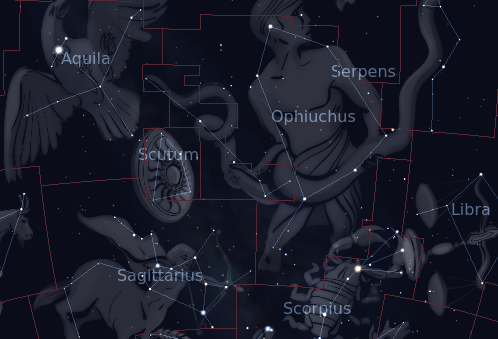The Constellation Serpens Cauda
Serpens is unique among the constellations in that it is divided into two separate pieces which are considered part of the same constellation.
It represents a snake which is usually depicted either wrapped around the waist of Ophiuchus the serpent bearer, or else wrapped behind his back.
When Eugène Delporte came to define the modern constellation boundaries in the 1920s, he faced the problem of how to separate the serpent and serpent-bearer into two separate constellations, and he opted to split the serpent into two parts.
Serpens is an equatorial constellation which appears highest in the evening sky in the months around June.
Both the head of the snake, Serpens Caput, and the tail of the snake, Serpens Cauda are represented by third and fourth magnitude stars
The head of the snake is well separated from the Milky Way, and contains no bright deep sky objects. The tail of the snake, however, not only lies close to the plane of the Milky Way, but also neighbors Sagittarius, the constellation which contains the galaxy's center. It is home to several bright open clusters and globular clusters.
Serpens is not the only snake in the night sky, and neither is it the largest. The largest of all the constellations is Hydra, the water snake, which also has a smaller and fainter companion in the far-southern sky, Hydrus.
Ancient
1.5% of the sky
636.9 square degrees
Serpens Cauda contains no Caldwell objects
The following constellations neighbor Serpens Cauda: Aquila, Ophiuchus, Sagittarius, Scutum.
Hover the pointer over the name of an object to highlight its position on the starchart to the right, or click to see more information.
| Stars | Open Clusters | Globular Clusters | Galaxies |
| η-Ser (mag 3.2) | IC 4756 (mag 4.6) | NGC 6539 (mag 8.9) | |
| ξ-Ser (mag 3.5) | Messier 16 (mag 6.0) | NGC 6535 (mag 9.3) | |
| O-Ser (mag 4.2) | NGC 6605 (mag 6.0) | IC 1276 (mag 10.3) | |
| ν-Ser (mag 4.3) | NGC 6604 (mag 6.5) | ||
| Alya (mag 4.6) | |||
| ζ-Ser (mag 4.6) | |||
| θ²-Ser (mag 4.9) | |||
| d Ser (mag 5.3) | |||
| c-Ser (mag 5.4) | |||
| HIP 89851 (mag 5.4) | |||
| HIP 86019 (mag 5.5) | |||
| 64-Ser (mag 5.6) | |||
| HIP 90497 (mag 5.7) | |||
| HIP 86313 (mag 5.7) | |||
| HIP 88684 (mag 5.7) | |||
| e-Ser (mag 5.8) | |||
| HIP 88670 (mag 5.9) | |||
| HIP 87074 (mag 5.9) | |||
| HIP 87813 (mag 5.9) | |||
| 61-Ser (mag 5.9) | |||
| HIP 86266 (mag 5.9) | |||
| HIP 89587 (mag 6.0) | |||
| HIP 89977 (mag 6.1) | |||
| HIP 92968 (mag 6.1) | |||
| HIP 87540 (mag 6.2) | |||
| HIP 92254 (mag 6.2) | |||
| HIP 85397 (mag 6.2) | |||
| HIP 89623 (mag 6.3) | |||
| HIP 89512 (mag 6.4) | |||
| HIP 90174 (mag 6.4) |




